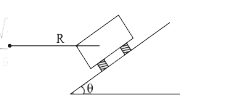A car is moving on a circular path and takes a turn. If R1 and R2 be the reactions on the inner and outer wheels respectively, then
Reaction on inner wheel
R1=12M[g−v2hra]
Reaction on outer wheel R2=12[g+v2hra]
where, r = radius of circular path, 2a = distance between two wheels and h = height of centre of gravity of car.
Therefore R1<R2
Topper's Solved these Questions
- BOOK - ICSECHAPTER - SAMPLE QUESTION PAPER 4EXERCISE - SECTION - C (Answer all questions.)9videos
SAMPLE QUESTION PAPER 4
- BOOK - ICSECHAPTER - SAMPLE QUESTION PAPER - 01 EXERCISE - SECTION - D12videos
SAMPLE QUESTION PAPER - 01
- BOOK - ICSECHAPTER - SAMPLE QUESTION PAPER 5EXERCISE - SECTION - D (Answer all questions.)6videos
SAMPLE QUESTION PAPER 5
Similar Questions
For a car taking a turn on a horizontal surface, let N1 and N2 be the normal reactions of the road on the inner and outer wheels respectively
View SolutionFor a car taking a turn on a horizontal surface, let N1 and N2 be the normal reactions of the road on the inner and outer wheels respectively
View SolutionWhen a car negotiates a curve, the normal force exerted on the inner and outer wheels are N2 and N1 respectively. Then N1/N2 is
View SolutionA particle is moving around a circular path with uniform angular speed (x) . The radius of the circular path is (r). The acceleration of the particle is:
View SolutionTwo buses A and B are moving around concentric circular pathe of radii rA and rB If the two buses complete the circular paths in the sme time. The ratio on their linear speeds is
View SolutionTwo buses A and B are moving around concentric circular pathe of radii rA and rB If the two buses complete the circular paths in the sme time. The ratio on their linear speeds is
View SolutionA car is moving on a circular road which is rough and banked at angle . If radius of circular track is R then. Choose correct statement:
 View Solution
View SolutionTwo particles of same mass are revolving in circular paths having radii r1 and r2 with the same speed. Compare their centripetal forces.
View SolutionA car of mass m is moving on a level circular track of radius R if μs represents the static friction between the road and tyres of the car, the maximum speed of the car in circular motion is given by.
View SolutionA particle is moving in a circular path of radius r. The displacement after half a circle would be
View Solution

